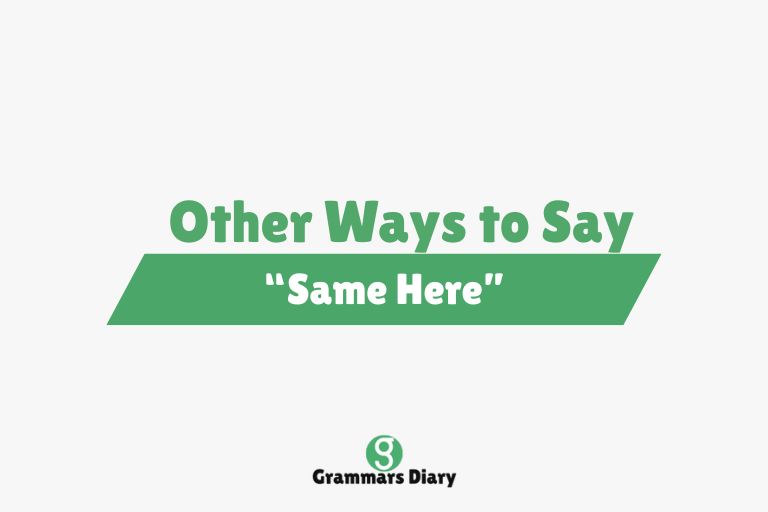“Same here” is one of those expressions that we use all the time without giving it a second thought. Whether you’re agreeing with someone about the weather, a shared opinion, or even how tired you both feel, it’s a quick and casual way to say “I feel the same” or “Me too.” But what if you’re looking to switch things up a bit?
This article explores a wide variety of expressions that can be used in place of “same here,” helping you to expand your conversational vocabulary while still maintaining that sense of connection and relatability.
Other Ways to Say “Same Here”
- Me too
Example: “I could really go for a nap right now.” — “Me too.”
Meaning: Expresses agreement or shared experience in a very casual and friendly way.
Usage: Ideal for everyday, informal interactions. - I feel the same way
Example: “I think this movie is overrated.” — “I feel the same way.”
Meaning: Indicates emotional or intellectual alignment with someone else’s point of view.
Usage: Works well in both casual and slightly formal conversations. - So do I
Example: “I love morning coffee.” — “So do I.”
Meaning: Used to express shared preference or habit with the speaker.
Usage: Polished and appropriate in all kinds of conversations. - Likewise
Example: “It was great talking to you.” — “Likewise.”
Meaning: A formal or semi-formal way to reciprocate a sentiment.
Usage: Often used in farewells or polite exchanges. - I agree
Example: “That policy doesn’t make much sense.” — “I agree.”
Meaning: Straightforward expression of agreement.
Usage: Fits well in discussions where opinions are being shared. - Ditto
Example: “I’m starving.” — “Ditto.”
Meaning: A playful and informal way of saying you feel the same.
Usage: Best used in lighthearted, casual conversations. - You took the words right out of my mouth
Example: “This place is freezing.” — “You took the words right out of my mouth.”
Meaning: Suggests strong agreement, as if you were about to say the same thing.
Usage: Very conversational and expressive. - That goes for me too
Example: “I’m not a fan of crowded spaces.” — “That goes for me too.”
Meaning: Used to echo someone else’s feelings or thoughts.
Usage: Semi-formal to informal; fits in personal conversations. - I second that
Example: “Let’s order pizza tonight.” — “I second that.”
Meaning: A playful or semi-serious way of showing agreement.
Usage: Suitable for both casual and professional group settings. - Absolutely
Example: “I think we should call it a day.” — “Absolutely.”
Meaning: Enthusiastic expression of agreement.
Usage: Works well in both casual and formal environments depending on tone. - I couldn’t agree more
Example: “This is the best decision we’ve made all week.” — “I couldn’t agree more.”
Meaning: Strong endorsement or complete agreement with someone’s statement.
Usage: Very effective in discussions to show support. - Totally
Example: “That joke was hilarious.” — “Totally.”
Meaning: Slangy and very informal way to affirm shared feelings or thoughts.
Usage: Best suited for friendly, relaxed conversations. - That’s exactly how I feel
Example: “I’m just not in the mood to socialize today.” — “That’s exactly how I feel.”
Meaning: Reinforces emotional or mental alignment.
Usage: Suitable when you want to emphasize shared mood or emotion.
More in next chunk…
- I was just thinking that
Example: “We should take a break soon.” — “I was just thinking that.”
Meaning: Expresses shared thought or simultaneous realization.
Usage: Great for showing that you’re on the same wavelength with someone. - Exactly
Example: “This doesn’t feel right.” — “Exactly.”
Meaning: Concise agreement, usually emphasizing precision in shared perspective.
Usage: Works in both casual chats and professional meetings. - I’m with you
Example: “This task is draining.” — “I’m with you.”
Meaning: Shows emotional or mental solidarity.
Usage: Friendly tone, ideal for peer or team interactions. - Preach
Example: “Mondays are the worst.” — “Preach.”
Meaning: Slang term that emphasizes strong agreement with a statement, as if you’re co-signing it like a sermon.
Usage: Very casual, often used humorously or playfully. - A hundred percent
Example: “That movie was amazing.” — “A hundred percent.”
Meaning: High-energy, slangy agreement, often showing enthusiastic support.
Usage: Works great in laid-back, informal conversations. - You’re telling me
Example: “This weather is unbearable.” — “You’re telling me.”
Meaning: Implies complete empathy and understanding of a shared situation.
Usage: Casual and expressive, suitable for complaints or observations. - Can’t argue with that
Example: “Ice cream is always a good idea.” — “Can’t argue with that.”
Meaning: Lighthearted way of agreeing with an obvious or agreeable statement.
Usage: Common in friendly discussions. - You and me both
Example: “I need a vacation.” — “You and me both.”
Meaning: Emphasizes shared feelings or needs, usually involving relief or fatigue.
Usage: Friendly and informal. - Same difference
Example: “I call it soda, you call it pop.” — “Same difference.”
Meaning: Suggests that the difference is negligible or not worth discussing.
Usage: Often used humorously in casual conversations. - I thought the same thing
Example: “That meeting felt a bit rushed.” — “I thought the same thing.”
Meaning: Indicates a previous alignment of thought or opinion.
Usage: Neutral tone, usable in both formal and casual exchanges. - I’m in the same boat
Example: “I’m struggling to focus today.” — “I’m in the same boat.”
Meaning: Shows that you’re experiencing the same challenge or situation.
Usage: Relatable and friendly, often used in shared difficulties. - My thoughts exactly
Example: “We should probably call it a night.” — “My thoughts exactly.”
Meaning: Strong alignment with the timing or content of someone’s idea.
Usage: Effective in both casual and more serious conversations.
When to Use Different “Same Here” Alternatives
In Professional Settings
In a work environment, you might want to choose alternatives that sound a little more polished and respectful—like “I agree,” “So do I,” or “I feel the same way”—especially during meetings, presentations, or discussions where tone and clarity matter.
In Everyday Conversations
For casual talks with friends, classmates, or family, expressions like “me too,” “ditto,” “totally,” or “you and me both” are not only easy to use but also help keep the mood light, relatable, and natural.
In Social Media or Text Messages
When chatting or commenting online, slang expressions like “preach,” “a hundred percent,” or “same difference” give your language a modern and playful edge, perfect for digital spaces where tone can be looser and more expressive.
Conclusion
While “same here” is a go-to phrase for expressing shared experience or agreement, exploring other options can add personality, clarity, or even humor to your conversations. Whether you’re chatting casually with a friend or participating in a team discussion at work, having a variety of expressions at your fingertips makes you a more dynamic and engaging communicator.
FAQs
What does “same here” mean?
It’s a casual way of saying that you feel the same way or agree with what someone else just said.
Is “same here” formal?
Not particularly. It’s best used in casual or semi-formal situations, but other phrases like “I agree” or “I feel the same way” can work better in formal contexts.
Can “ditto” and “same here” be used interchangeably?
Yes, both express agreement, but “ditto” is more playful and might sound less polished in certain settings.
Are there emotional or humorous alternatives to ‘same here’?
Absolutely—phrases like “preach,” “you and me both,” and “you took the words right out of my mouth” add extra flair and emotion to simple agreement.











